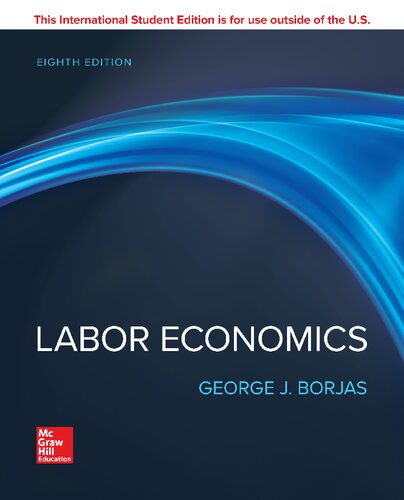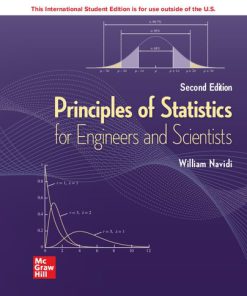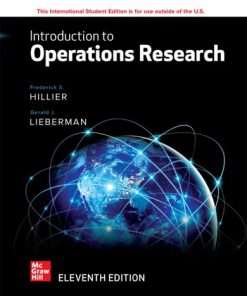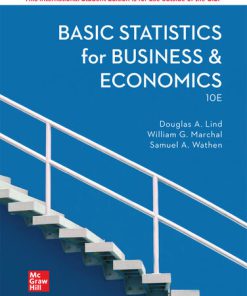ISE Labor Economics 8th Edition by George Borjas ISBN 1260568555 9781260568554
$50.00 Original price was: $50.00.$25.00Current price is: $25.00.
ISE Labor Economics 8th Edition by George Borjas – Ebook PDF Instant Download/Delivery: 1260568555, 9781260568554
Full download ISE Labor Economics 8th Edition after payment
Product details:
ISBN 10: 1260568555
ISBN 13: 9781260568554
Author: George Borjas
ISE Labor Economics 8th Edition: Labor Economics, eighth edition by George J. Borjas provides a modern introduction to labor economics, emphasizing both theory and empirical evidence. The book uses many examples drawn from state-of-the-art studies in labor economics literature. The author introduces, through examples, methodological techniques that are commonly used in labor economics to empirically test various aspects of the theory.
Labor Economics is thoroughly integrated with the adaptive digital tools available in McGraw-Hill’s Connect, proven to increase student engagement and success in the course.
ISE Labor Economics 8th Edition Table of contents:
Chapter 1: Introduction
- An Economic Story of the Labor Market
- The Actors in the Labor Market
- Why Do We Need a Theory?
- Summary
- Review Questions
- Key Concepts
- Appendix: An Introduction to Regression Analysis
- Key Concepts
Chapter 2: Labor Supply
- Measuring the Labor Force
- Basic Facts about Labor Supply
- The Worker’s Preferences
- The Budget Constraint
- The Hours of Work Decision
- To Work or Not to Work?
- The Labor Supply Curve
- Estimates of the Labor Supply Elasticity
- Household Production
- Correlation versus Causation: Searching for Random Shocks
- Policy Application: Welfare Programs and Work Incentives
- Policy Application: The Earned Income Tax Credit
- Labor Supply over the Life Cycle
- Policy Application: Disability Benefits and Labor Force Participation
- Theory at Work: Dollars and Dreams
- Theory at Work: Gaming the EITC
- Summary
- Key Concepts
- Review Questions
- Problems
- Selected Readings
Chapter 3: Labor Demand
- The Production Function
- The Short Run
- The Long Run
- The Long-Run Demand Curve for Labor
- The Elasticity of Substitution
- What Makes Labor Demand Elastic?
- Factor Demand with Many Inputs
- Overview of Labor Market Equilibrium
- Rosie the Riveter as an Instrumental Variable
- Policy Application: The Minimum Wage
- Theory at Work: California’s Overtime Regulations
- Theory at Work: The Minimum Wage and Drunk Driving
- Summary
- Key Concepts
- Review Questions
- Problems
- Selected Readings
Chapter 4: Labor Market Equilibrium
- Equilibrium in a Single Labor Market
- Equilibrium across Labor Markets
- Policy Application: Payroll Taxes and Subsidies
- Policy Application: Mandated Benefits
- The Labor Market Impact of Immigration
- The Immigration Surplus
- Policy Application: High-Skill Immigration
- The Cobweb Model
- Monopsony
- Theory at Work: The Intifadah and Palestinian Wages
- Theory at Work: Hurricanes and the Labor Market
- Summary
- Key Concepts
- Review Questions
- Problems
- Selected Readings
Chapter 5: Compensating Wage Differentials
- The Market for Risky Jobs
- The Hedonic Wage Function
- Policy Application: How Much Is a Life Worth?
- Policy Application: Safety and Health Regulations
- Compensating Differentials and Job Amenities
- Policy Application: Health Insurance and the Labor Market
- Theory at Work: Jumpers in Japan
- Theory at Work: The Value of Life on the Interstate
- Summary
- Key Concepts
- Review Questions
- Problems
- Selected Readings
Chapter 6: Education
- Education in the Labor Market: Some Stylized Facts
- Present Value
- The Schooling Model
- Education and Earnings
- Estimating the Rate of Return to School
- Policy Application: School Construction in Indonesia
- Policy Application: The Education Production Function
- Do Workers Maximize Lifetime Earnings?
- Signaling
- Theory at Work: Destiny at Age 6
- Theory at Work: Booker T. Washington and Julius Rosenwald
- Summary
- Key Concepts
- Review Questions
- Problems
- Selected Readings
Chapter 7: The Wage Distribution
- Postschool Human Capital Investments
- On-the-Job Training
- The Age–Earnings Profile
- Policy Application: Training Programs
- Wage Inequality
- Measuring Inequality
- The Changing Wage Distribution
- Policy Application: Why Did Inequality Increase?
- Inequality Across Generations
- Theory at Work: Earnings and Substance Abuse
- Theory at Work: Computers, Pencils, and the Wage Distribution
- Summary
- Key Concepts
- Review Questions
- Problems
- Selected Readings
Chapter 8: Labor Mobility
- Migration as a Human Capital Investment
- Internal Migration
- Family Migration
- The Self-Selection of Migrants
- Immigrant Assimilation
- The Job Match and Job Turnover
- Job Turnover and the Age–Earnings Profile
- Theory at Work: Power Couples
- Theory at Work: Health Insurance and Job Lock
- Summary
- Key Concepts
- Review Questions
- Problems
- Selected Readings
Chapter 9: Labor Market Discrimination
- Race and Gender in the Labor Market
- The Discrimination Coefficient
- Employer Discrimination
- Employee Discrimination
- Customer Discrimination
- Statistical Discrimination
- Experimental Evidence
- Measuring Discrimination
- Policy Application: The Black–White Wage Gap
- The Relative Wage of Hispanic and Asians
- Policy Application: The Male–Female Wage Gap
- Theory at Work: Beauty and the Beast
- Theory at Work: Orchestrating Impartiality
- Theory at Work: Shades of Black
- Summary
- Key Concepts
- Review Questions
- Problems
- Selected Readings
Chapter 10: Labor Unions
- A Brief History of American Unions
- Determinants of Union Membership
- Monopoly Unions
- Policy Application: The Efficiency Cost of Unions
- Efficient Bargaining
- Strikes
- Union Wage Effects
- Policy Application: Public-Sector Unions
- Theory at Work: The Rise and Fall of PATCO
- Theory at Work: The Cost of Labor Disputes
- Theory at Work: Occupational Licensing
- Summary
- Key Concepts
- Review Questions
- Problems
- Selected Readings
Chapter 11: Incentive Pay
- Piece Rates and Time Rates
- Tournaments
- Policy Application: The Compensation of Executives
- Policy Application: Incentive Pay for Teachers
- Work Incentives and Delayed Compensation
- Efficiency Wages
- Theory at Work: Windshields by the Piece
- Theory at Work: How Much Is a Soul Worth?
- Theory at Work: Did Henry Ford Pay Efficiency Wages?
- Summary
- Key Concepts
- Review Questions
- Problems
- Selected Readings
Chapter 12: Unemployment
- Unemployment in the United States
- Types of Unemployment
- The Steady-State Rate of Unemployment
- Job Search
- Policy Application: Unemployment Compensation
- The Intertemporal Substitution Hypothesis
- The Sectoral Shifts Hypothesis
- Efficiency Wages and Unemployment
- Policy Application: The Phillips Curve
- Theory at Work: Graduating During a Recession
- Theory at Work: Cash Bonuses and Unemployment
People also search for ISE Labor Economics 8th Edition:
is labor economics
what is considered labor in economics
is labor an economic resource
is labor social or economic
economics labor quizlet
Tags:
George Borjas,ISE,Labor,Economics
You may also like…
Science (General)
Business & Economics - Mathematical Economics
Business & Economics
Business & Economics - Economics
Business & Economics - Mathematical Economics
Uncategorized












